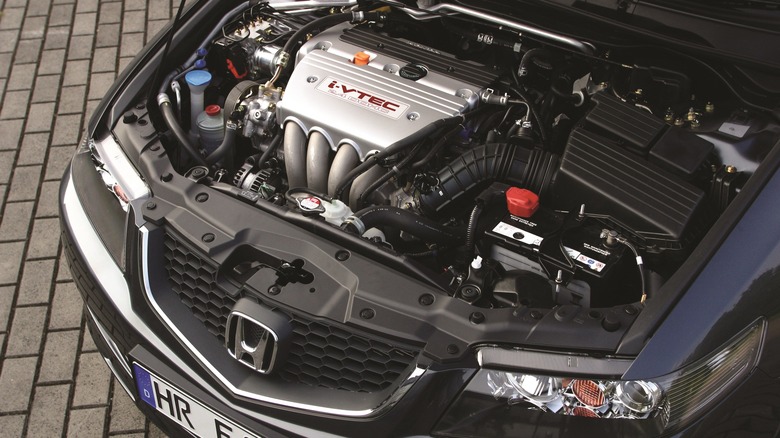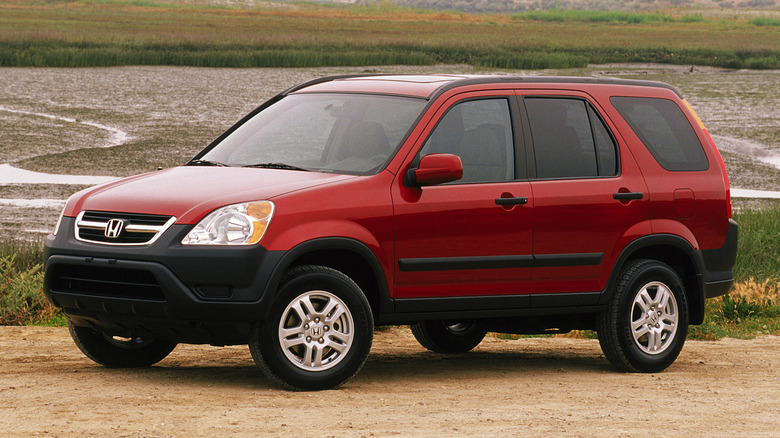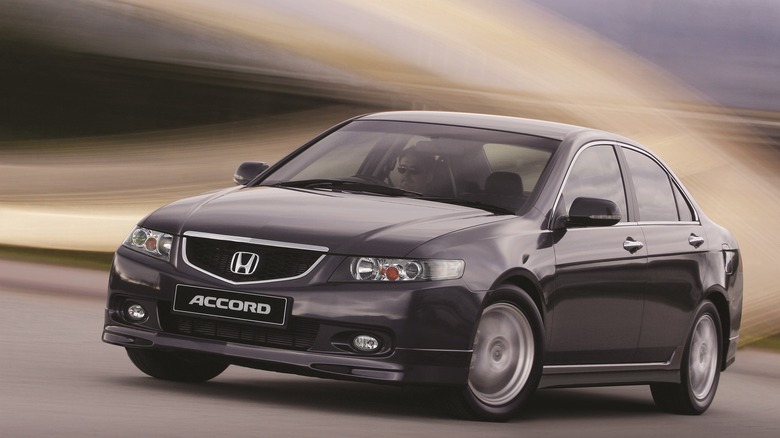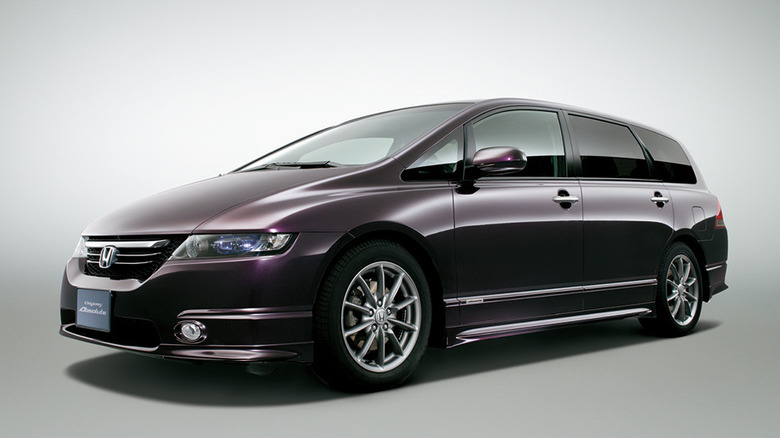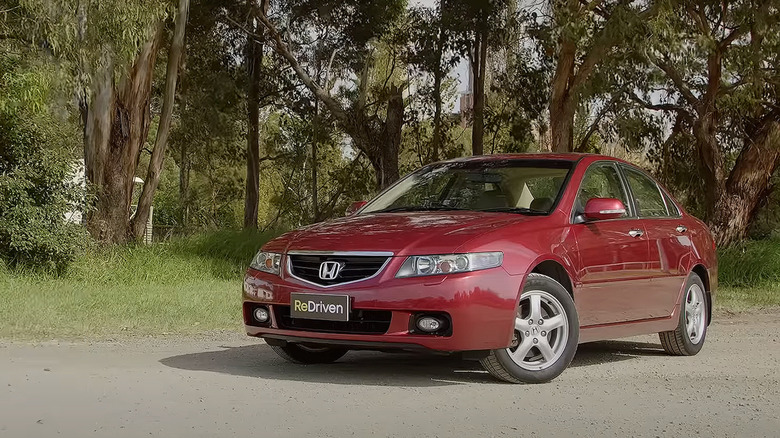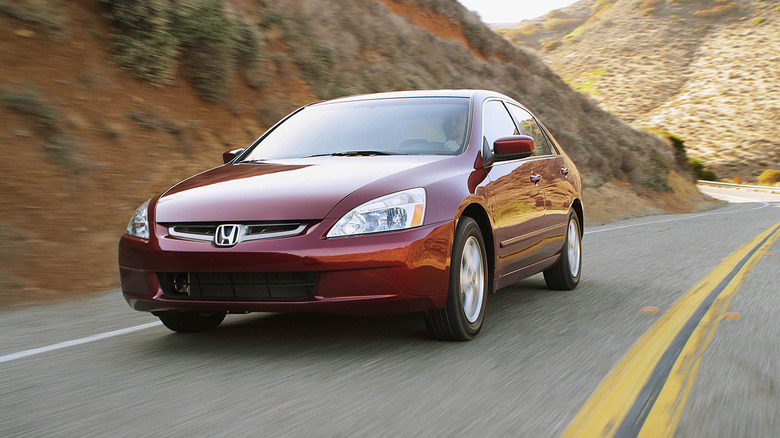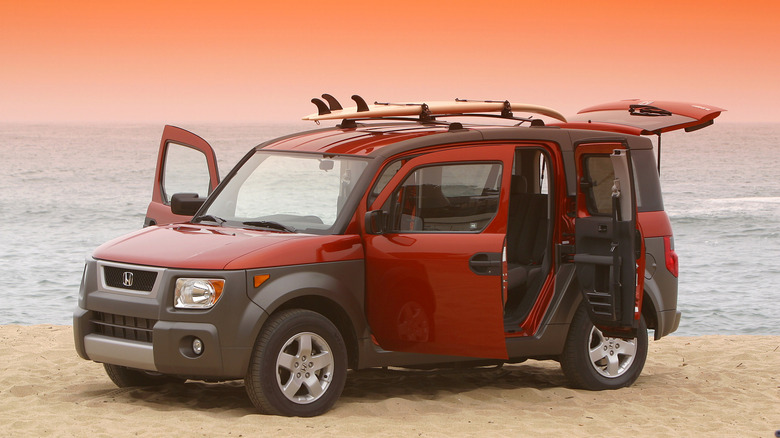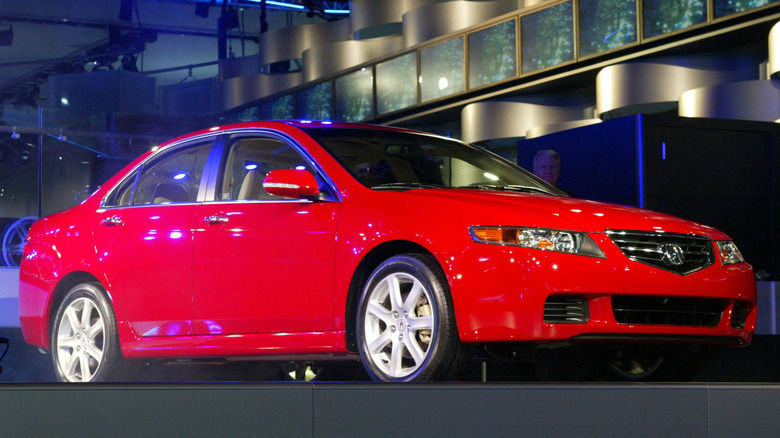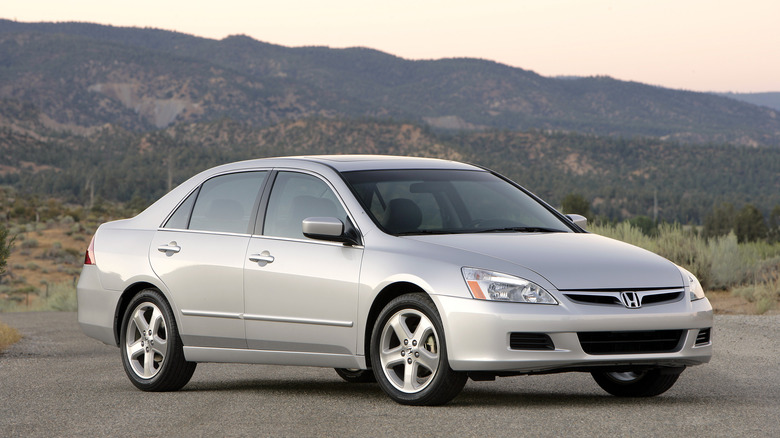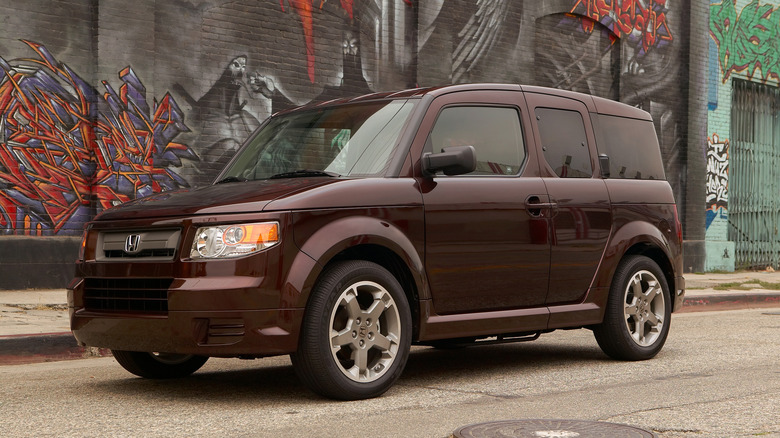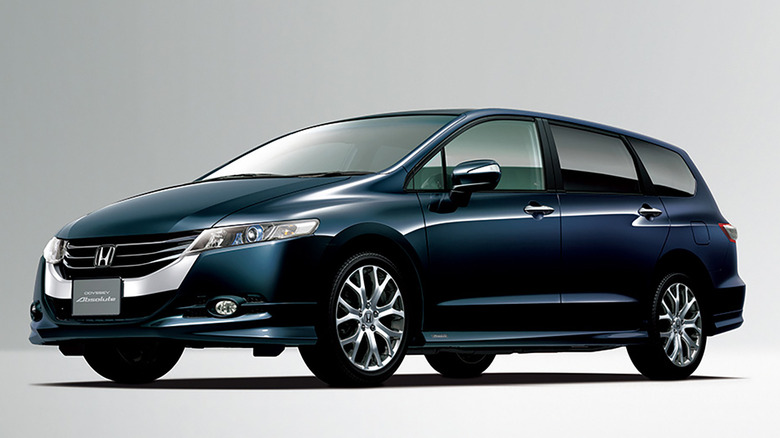Every Honda Model Powered By The K24A Engine
Honda is an automaker that captures the attention of both regular car buyers and automotive enthusiasts. It's a company with an exceptional motorsport heritage that also makes some of the most reliable and efficient family cars available. Crucially, Honda has always strived toward engineering excellence in a compact package. Thus, it has become synonymous with reliable and powerful low-capacity engines, like the coveted K24A – one of the best K-series Honda engines out there.
The 2.4-liter four-cylinder K24A, with its dual overhead camshaft design and aluminum block, has found its way into numerous Honda vehicles. Once, it was the bread-and-butter engine of the Japanese automaker, together with the smaller K20. Today, it is known for being among the most reliable four-cylinder JDM engines ever and the K24A is also popular for engine swaps. Following Honda's ethos of producing cars for everyone, the K24A has been a staple among its economy vehicles too, like crossovers and minivans.
But which cars have been powered by the K24A engine? Whether you need one for your project car or just want to be informed, this article will give you the answer. It will include models from various markets and different versions of the engine. Still, each engine will belong to the K24A family, meaning the K24Z, K24Y, K24W, and K24V won't be covered. With that out of the way, let's have a closer look at all of the K24A-powered cars!
2002-2009 Honda CR-V – K24A1
The CR-V is one of the most popular models in Honda's North American lineup. When the first generation arrived stateside in 1997, it was more of an off-road-focused compact SUV, but Honda quickly learned its lesson and the second-generation CR-V was a road-focused vehicle. One of the changes it made was equipping this compact crossover/SUV with a larger 2.4-liter K24A1 engine, compared to the 2.0-liter one in the predecessor.
The all-new engine featured Honda's advanced i-VTEC variable valve control system and dual-stage intake, helping it achieve greater power and efficiency. With 160 hp and 162 lb-ft of torque on tap, it was fairly sprightly, especially for the era. In the beginning, Honda paired the engine with a five-speed manual or a four-speed automatic transmission. However, from 2005 onward, a five-speed automatic replaced the four-speed one.
You might notice that from 2006, power and torque figures were down to 156 hp and 160 lb-ft. Still, that was only because of the revised Society of Automotive Engineers (SAE) J1349 (Rev 8/04) net calculations. Thus, the 0-60 mph time of 8.4 seconds (with the manual) is applicable to all K24A1-powered CR-Vs.
Crucially, the CR-V offered passengers a vast amount of space for their legs, shoulders, and heads. Despite its compact dimensions, it also had a huge 4.8 cubic feet cargo area. Meanwhile, the added sound-deadening made the CR-V a better option for longer journeys. All things considered, with the second-gen CR-V, Honda found the perfect family crossover/SUV formula.
2002-08 Honda Accord Type-S – K24A2
While North American buyers could enjoy a more powerful and torquier K24A1 in the 2002-2008 CR-V, Honda treated its Japanese and European customers to the much more interesting K24A2 engine. This 2.4-liter unit was a higher-output version of the same engine, producing 190 hp @6,800 rpm and 162 lb-ft @4,500 rpm. The car that received this engine was the Honda Accord Type-S — sold as the Acura TSX in North America.
The overseas Accord was a sedan with sporty aspirations, and that was especially true for the Type-S model. Although not a full-fledged Type-R variant, it was a capable car in the right hands. It was more a "Si" version of the Accord, rather than something like the more enthusiast-oriented Acura Integra Type S sold today. As such, the Accord Type-S was a very enjoyable car to drive, with balanced handling, a slick-shifting six-speed manual, and a four-cylinder engine that liked to be revved — just like any other Honda from the 2000s. It was also quick in a straight line; the 0-62 mph sprint took 7.9 seconds, with the top speed being 141 mph.
Crucially, the 2002-2008 Honda Accord Type-S was also designed for transporting families. It boasted a spacious interior and a 16 cubic foot cargo area, which made it a good buy among enthusiast parents. Its pointy nose and sharp body lines also looked very chic. No wonder it was named the 2002 Japanese Car of the Year.
2003-08 Honda Odyssey / Odyssey Absolute – K24A2 & K24A4
The 2003-2008 Odyssey minivan for the Japanese and Australian markets, which was different from the North American Odyssey, epitomizes the versatility of the K24A family. Available with two different engine tunes, the Odyssey showed what was possible from the platform with only a few modifications. The entry-level model, equipped with the K24A4 variant, had 158 hp on tap and was mated to either a CVT (front-wheel-drive) or a five-speed automatic (all-wheel-drive).
The star of the show was the K24A2 variant in the Odyssey Absolute, though. This model had 197 hp @6,800 rpm and 171 lb-ft of torque, paired exclusively to a five-speed automatic. Both FWD and AWD versions were available, and the Absolute also received specially tuned suspension and brakes, as well as a sporty body kit. All Odyssey models also had a variable-steering gear ratio (VGR), giving the minivan agility at lower speeds and stability on the highway.
It's sad that Honda didn't care to equip the Odyssey Absolute with a manual transmission, but this is a family car, so an automatic was a better solution. The interior was full of practical features, like a low-floor design for easier egress and access to multi-level parking facilities and easily foldable second and third-row seats. Honda managed to package all that in a very attractive body — the low-slung Odyssey looks very streamlined and sporty, especially for a minivan!
2003-07 Honda Accord Euro – K24A3
Australians and New Zealanders have always enjoyed some great JDM cars, most of which never arrive on U.S. shores. One such vehicle is the Honda Accord Euro, which was similar to the Accord Type-S for the Japanese and European markets, albeit with slightly less power. Namely, the K24A3 unit in the Accord Euro was good for 188 hp and 164 lb-ft of torque and had a 7,200 rpm redline.
Like the Accord Type-S, the Euro was designed to offer the driver a more spirited experience, but without damaging the comfort bits. Even so, the slick Honda shifter and balanced chassis made the Accord Euro enjoyable on twisty roads, of course, accompanied by that high-revving K24A3 engine. Inside, Honda also equipped its sporty sedan with Recaro seats, which added to the experience.
Of course, like any Honda with a K24A engine, the Accord Euro enjoys good aftermarket support and can be easily tuned past 200 hp. Naturally-aspirated builds are more popular, but you could also go the forced-induction route for maximum power gains. Either way, the K24A3 is a solid starting point. Still, the 220-hp Accord Euro-R is an even more attractive proposition, as it is one of the most affordable yet powerful JDM cars.
2003-05 Honda Accord – K24A4
While overseas buyers enjoyed fun and stylish Accords, North America got a version that was more of a mundane car, even in its coupe form. That was particularly true for the models equipped with the K24A4 engine, which in this application made 160 hp and 161 lb-ft of torque and was accompanied by either a five-speed manual or five-speed automatic. It was a fairly advanced engine for the era, boasting Honda's i-VTEC with Variable Timing Control (VTC), allowing it to meet the super ultra-low emissions vehicle (SULEV) regulations.
Honda did offer a 3.0-liter V6, though, churning an impressive 240 hp, though that model was heavier and less agile in the corners, particularly when compared to the Accord in other markets. Both models were devoid of driving fun and emotion, though, putting Honda's mid-size vehicle firmly in "conservative car" territory. The styling only added fuel to the fire, as it looks quite unremarkable.
Still, that didn't bother American buyers because the 2003-2005 Accord was otherwise an excellent cruiser. Silky-smooth engines, quiet and roomy cabin, and excellent long-distance comfort gave the seventh-gen North American Accord sedan and coupe an edge over its competitors.
2003-06 Honda Element – K24A4
Honda had no shortage of quirky cars, particularly for its domestic market. However, in 2003, the company decided to use some of that special JDM sauce in an eccentric compact SUV called the Element. People were baffled by the design, and many even hated the Honda Element. Still, there was a method to this madness — it was all for practicality.
Namely, the Element has one of the most functional interiors of any vehicle ever made, period. You could, for example, lay down all the seats and create two sleeping positions. The seats could also fold to the side to give you a long, flat floor resistant to scratching, thanks to the thermoplastic polyolefin material. Heck, the seats were even dressed up in stain-resistant fabric. Oh, and you could even remove all seats and use the Element as a cargo van. The possibilities were endless.
The engine that powered this peculiar vehicle was the K24A4, the same as the North American Accord. Here, though, the 2.4-liter unit was paired to a four-speed automatic or a five-speed manual and either an FWD or 4WD system. The 4WD model was designed to be a lifestyle SUV that can take you anywhere; think of it as a surfer vehicle or a compact overlander, and you won't be far off.
2004-08 Acura TSX – K24A2
The Acura TSX was the same vehicle as the Honda Accord for overseas markets. Call it badge-engineering if you want, but in this instance, Honda at least chose a capable and well-engineered car to begin with. That said, because Acura is Honda's luxury brand, the TSX was far better equipped than the overseas Accord and got perforated leather seats and a 360-watt stereo. Interior materials were generally more luxurious, too. And they needed to be, as the TSX was trying to compete with the Audi A4 and BMW 3-Series.
The TSX was more powerful than the Accord. Although Honda used the same engine code for its 2.4-liter engine (K24A2), this iteration made 200 hp @6,800 rpm and 166 lb-ft @4,500 rpm, with a 7,100-rpm redline. The showstopper six-speed manual featured multicone synchronizers and short shift throws, providing a best-in-class shifting experience. Provided you were fast with the shifter, you could also reach 60 mph in 7.2 seconds, similar to most six-cylinder sports sedans of the era.
To differentiate the TSX from the American Accord, Acura also equipped it with a strut brace on the front axle and a stiffer 15-millimeter anti-roll bar on the back axle. As a result, the TSX was sharper in the corners, with less body roll and a much higher grip. Fortunately, the ride didn't suffer. All things considered, this might have been the best application of the K24A2 engine. So, Honda didn't cheat the North American market after all!
2006-07 Honda Accord – K24A8
For the 2006 model year, Honda refreshed the Accord with upgraded exterior styling that included changes in the front bumper and grille, rear bumper, and new LED taillights. It was still not enough to make it attractive, but the 2006-2007 Accord at least looked more polished.
The engines got massaged, too, with the 2.4-liter unit now producing 166 hp @5,800 rpm and 160 lb-ft of torque @4,000 rpm. Now coded K24A8, the improved engine had Drive-by-Wire throttle control and high-performance intake and exhaust timing. As a result, it was fairly economical, rated at 24/34 mpg city/highway. The V6 option was also more potent, producing 244 hp, and from 2005, there was also a V6 hybrid with 253 hp on tap.
Although the engines were more powerful, they didn't magically turn the North American Accord into a driver's car. Instead of chasing agility and stability, Honda doubled down on comfort, adding more sound-deadening materials and new seat fabrics. Most models, apart from the V6 Accord Coupe, also featured a five-speed automatic, which wasn't designed with sportiness in mind. So, yes, the 2006-2007 Accord is still a forgettable car, but its K24A8 engine is at least a good project-car platform.
2007-11 Honda Element – K24A8
The Honda Element also received the revised K24A8 engine from 2007, meaning it had 166 hp @5,800 rpm and 160 lb-ft of torque @4,000 rpm to play with. Much like the unit in the 2006-2007 Accord, this one also had a Drive-by-Wire Throttle System. The bigger upgrade was the jump from a four-speed to a five-speed automatic transmission, which was now in line with other Honda models. The refreshed Element also received standard side curtain airbags, VSA, and Brake Assist, so it was safer, too.
However, Honda tried to really spice things up with the Element SC. Featuring a 20-millimeters lower ride height, huge 18-inch wheels, and an aerodynamic kit, the SC looked like a SEMA edition of the Element SUV. This trim even got a carpeted interior, which felt more luxurious, although it made the Element less practical, as other trims got an easy-to-clean and scratch-resistant thermoplastic polyolefin material. It was still not enough to keep the Element alive, as the model got axed in 2011.
2008-14 Honda Odyssey – K24A2 & K24A8
Much like in its North American Accord and Element models, Honda used the improved K24A8 engine in the all-new, fourth-gen Odyssey minivan in Japan. Fortunately, Honda continued to offer the Absolute model with the K24A2 engine, producing 203 hp @7,000 rpm and 171 lb-ft of torque. Meanwhile, the regular model was rated at 171 hp and 162 lb-ft of torque.
Like its predecessor, the 2008 Odyssey was offered in FWD and 4WD trims, with the former paired to a torque-converted CVT and the latter to a five-speed automatic. A manual would've been a brilliant addition to the Odyssey Absolute, but Honda probably thought buyers wouldn't want to bother with shifting gears.
The Odyssey received improvements in crucial areas. For instance, the fourth-gen model had an even lower center of gravity, ensuring better driving dynamics without sacrificing ride quality. There was also less noise in the cabin, thanks to a more rigid chassis and strategically placed vibration-absorbing materials.
Moreover, passengers could now enjoy more legroom (40 millimeters more in the second row, and 20 millimeters more in the third row), and the V-shaped seat configuration allowed all travelers a clear view forward. Thanks to a thinner tailgate, the fourth-gen Odyssey had a larger cargo area, too. And, dare we say, it looks very dynamic, leaving a bullet train impression!
